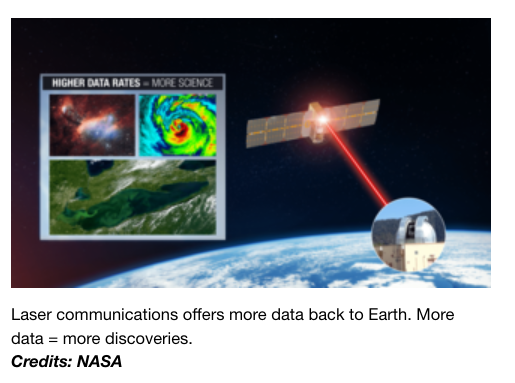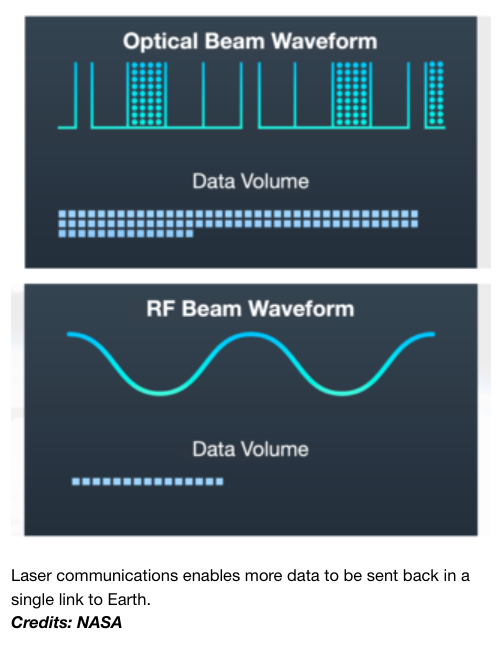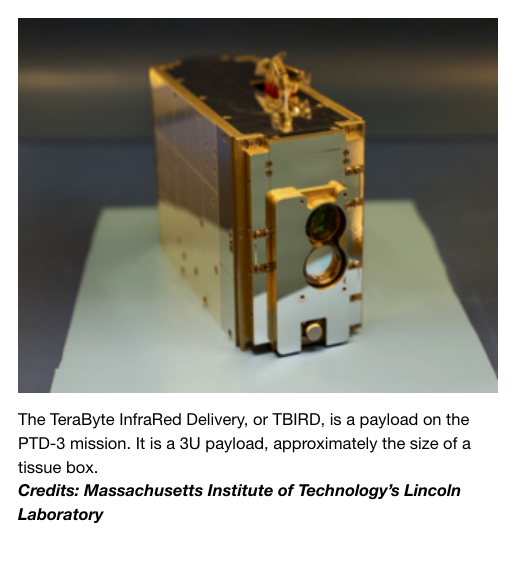日本語で読みたい方は、
google chromeで開いて、
画面上で右クリックをして
「日本語に翻訳」をクリックしてください

On April 28, NASA and its partners achieved another major milestone in the future of space communications – achieving 200 gigabit per second (Gbps) throughput on a space-to-ground optical link between a satellite in orbit and Earth, the highest data rate ever achieved by optical communications technology.
These data rates are made possible by using laser communications, which packs information into the oscillations of light waves in lasers, instead of using radio waves like most space communications systems.

This communications link was achieved by the TeraByte InfraRed Delivery (TBIRD) system, carried into orbit by NASA’s Pathfinder Technology Demonstrator 3 (PTD-3) satellite, and surpasses the previous 100 Gbps milestone previously demonstrated by the same team in June 2022. With this speedy connection, TBIRD can send down multiple terabytes of test data to Earth during a single six-minute pass over a ground station. A single terabyte is the equivalent of about 500 hours of high-definition video.
“Achieving 100 Gbps in June was groundbreaking, and now we’ve doubled that data rate – this capability will change the way we communicate in space,” said Beth Keer, the mission manager for TBIRD at NASA’s Goddard Space Flight Center in Greenbelt, Maryland. “Just imagine the power of space science instruments when they can be designed to fully take advantage of the advancements in detector speeds and sensitivities, furthering what artificial intelligence can do with huge amounts of data. Laser communications is the missing link that will enable the science discoveries of the future.”
Currently, the most commonly used technology by NASA for space communications is radio, sending data with similar methods to how radio broadcasts are sent to a car radio or how a cell phone communicates with a cell tower. With NASA’s sights set on a long-term presence on the Moon and future missions to Mars, more efficient communications are essential for smooth mission operations and effective science.

The ultra-high-speed capabilities of laser communications, also known as optical communications, will make it possible to pack more data into each transmission from space. More information about whatever a scientific instrument may be studying – whether that be imagery of another world, data about space radiation, or something else – means there’s more data for scientists on Earth to study, leading to the discoveries that will be needed to live and work on other worlds.
CubeSats like PTD-3 are ideal spacecraft for testing communications technologies due to their cost-effectiveness and small size. PTD-3 is only about the size of two stacked cereal boxes, and the TBIRD payload it carries is no larger than the average tissue box. PTD-3 was built and is operated by Terran Orbital of Irvine, California, for NASA. The TBIRD payload was designed and built by Massachusetts Institute of Technology Lincoln Laboratory (MIT-LL) of Lexington, Massachusetts.
PTD-3 was launched into orbit on SpaceX’s Transporter-5 rideshare mission from NASA’s Kennedy Space Center in Florida, and synchronized with Earth’s orbit around the Sun in such a way that the small satellite entered a “fixed” position relative to the Sun. That means PTD-3 is able to pass over the ground station on Earth at the same time twice each day so TBIRD can test this space-to-ground communications link.

TBIRD’s data transmission milestone was made possible by collaborations across NASA centers and beyond. NASA’s Goddard Space Flight Center in Greenbelt, Maryland developed the TBIRD mission and concept in partnership with MIT-LL while NASA’s Ames Research Center in California’s Silicon Valley developed and manages the PTD-3 program and mission.
In addition to building the PTD-3 spacecraft, Terran Orbital worked with MIT Lincoln Laboratory to integrate the TBIRD payload onto the spacecraft, managed the launch, and operates the spacecraft. The ground station is located at the Optical Communications Test Laboratory (OCTL) at NASA’s Jet Propulsion Laboratory (JPL) in Southern California. OCTL currently supports multiple optical communications missions and was modified to accommodate the TBIRD system requirements and unique TBIRD communications ground hardware provided by MIT Lincoln Laboratory.
With TBIRD’s successful demonstration of laser communications as a practical tool for transferring data from space to ground, future NASA missions can integrate this technology into their designs. Data from space has never had a speedier path back to Earth than this.
This technology demonstration was a collaborative partnership between NASA’s Space Communications and Navigation (SCaN) program in NASA’s Space Operations Mission Directorate and the Small Spacecraft Technology program in NASA’s Space Technology Mission Directorate. Development of the TBIRD technology and payload were funded by SCaN, and the PTD-3 demonstration mission, part of the PTD mission series, was funded by the Small Spacecraft Technology program.
For news media:
Members of the news media interested in covering these topics should reach out to the Ames newsroom.
Last Updated: May 12, 2023
Editor: Frank Tavares
出典:
https://www.nasa.gov/feature/ames/tbird-milestone
In case of addition or removal of the article, please contact us as below:
info@symphotony.com
この情報へのアクセスはメンバーに限定されています。ログインしてください。メンバー登録は下記リンクをクリックしてください。

